Glycolic acid and retinol are two of the most popular skincare actives due to their effectiveness and ability to improve the look of your skin.
Glycolic acid is an alpha hydroxy acid (AHA) that exfoliates dead skin cells on the surface of your skin. Retinol is a vitamin A derivative that helps reduce fine lines and wrinkles by increasing collagen production.
Since they’re both great at fighting signs of aging, can you use glycolic acid and retinol together in the same skincare routine?
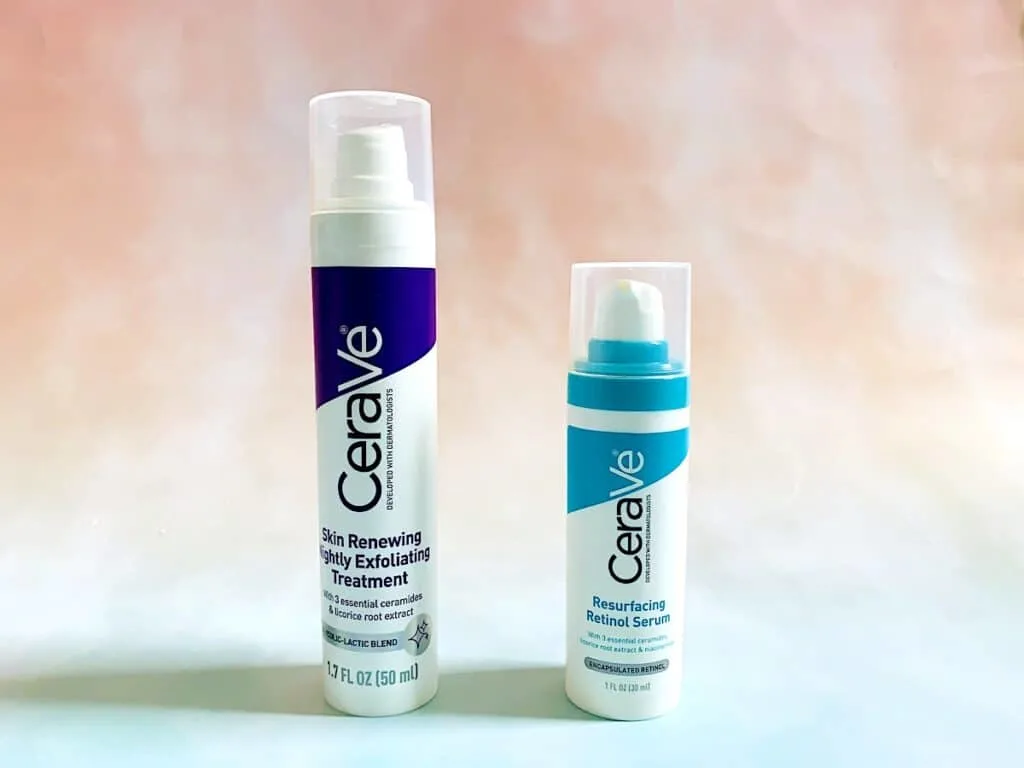
Due to the chemical composition and potency of glycolic acid and retinol, you run the risk of irritation and a reduction in effectiveness if you use them at the same time.
In general, glycolic acid and retinol should not be used at the same time unless you are using a product specially formulated with both ingredients or if you have a skin type that can withstand strong actives.
Let’s look at the factors that determine if glycolic acid and retinol can be used together in the same skincare routine.
This post on using glycolic acid and retinol together contains affiliate links, and any purchases made through these links will result in a commission for me at no extra cost to you. Please read my Disclosure for additional information.
Can You Use Glycolic Acid and Retinol Together?
First, let’s talk about chemical composition and pH. PH is the measure of the acidity or alkalinity of a solution. The pH scale ranges from 0 to 14, with 7 being neutral.
The skin’s natural pH tends to average about 4.7, which is slightly acidic.
While retinol tends to work best on your skin at a more neutral pH between 5.5 and 6, exfoliating acids like glycolic acid works best at an acidic pH between 3.0 and 4.0. So mixing pH levels could reduce the effectiveness of both actives.
Another reason that you may want to avoid using glycolic acid and retinol is that they both can cause irritation in some people, so using them together could increase irritation, dryness, redness, flaking, and peeling.
However, there are products that contain both glycolic acid and retinol that have been specially formulated to reduce the irritation that would normally occur from using these two ingredients simultaneously.
That being said, if you don’t have sensitive skin and can tolerate strong actives, you might be able to use the two together at lower concentrations.
This study demonstrated that retinoic acid and glycolic acid used together are effective at treating acne scars.
THE TAKEAWAY: If you don’t have sensitive skin and are using glycolic acid at lower concentrations, you may be able to use retinol with it.
However, if you have sensitive skin, it’s best to choose only one strong active at a time in your skincare routine.
How to Use Glycolic Acid and Retinol in Your Skincare Routine
Consider using glycolic acid in the morning and your retinol product in the evening since both ingredients can cause irritation and have reduced effectiveness when used together due to the variance in their pHs.
Or, you can alternate days that you use glycolic acid and retinol in your skincare routine.
If your skin is not sensitive and can withstand using glycolic acid and retinol together, start with low concentrations of both.
After cleansing and toning your skin in your PM skincare routine, apply glycolic acid (or retinol if it has a thinner texture) and then wait at least 30 minutes before using retinol to allow your skin’s pH to normalize.
This will help improve the effectiveness of both products.
Make sure to follow with a hydrating moisturizer, especially if you are using both actives at the same time since glycolic acid and retinol can dehydrate your skin.
Also, don’t forget to apply a broad-spectrum sunscreen daily to protect your skin since glycolic acid and retinol can make your skin more sensitive to the sun.
The Benefits of Glycolic Acid
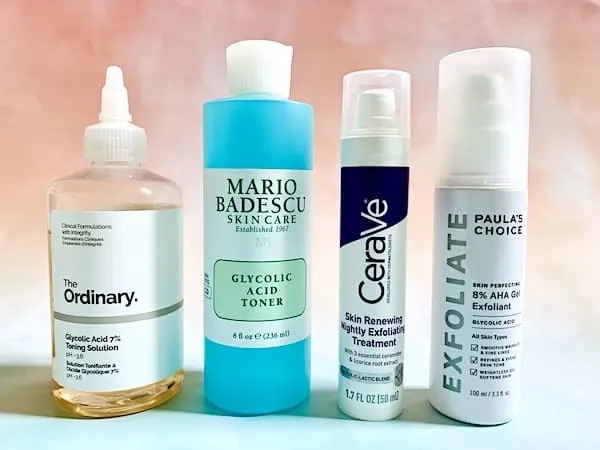
Derived from sugar cane, glycolic acid is an alpha hydroxy acid (AHA).
AHAs are exfoliating acids that remove dead skin cells on the skin’s surface, which helps to create softer, smoother, and brighter skin. Due to its small molecule size, glycolic acid can reach deeper than other AHAs making it more effective.
Glycolic acid increases cell turnover, which smoothes the look of fine lines and wrinkles and skin dullness. It also stimulates the production of collagen, so over time, glycolic acid helps improve skin firmness and elasticity.
Glycolic acid helps to fade hyperpigmentation, dark spots, and uneven skin tone. It can also help to reduce the look of acne scars from post-inflammatory hyperpigmentation.
Glycolic acid can help treat acne, although not as proven as benzoyl peroxide or the beta-hydroxy acid, salicylic acid.
Unfortunately, due to its small molecule size, glycolic acid may also cause irritation and redness in some skin types, especially those with sensitive skin.
In that case, you may wish to try AHAs with a larger molecule size like lactic acid or mandelic acid.
NOTE: Different concentrations of glycolic acid will have different levels of exfoliation, so if you are new to AHAs, consider starting with a lower concentration and slowly work your way up.
AHAs make your skin more sensitive to the sun, so regardless of the concentration of glycolic acid that you use, you should always apply a broad-spectrum sunscreen with an SPF of 30 or higher while using glycolic acid and other AHAs.
Related Post: AHA vs BHA vs PHA: What’s The Difference?
Glycolic Acid Products to Try
Mario Badescu Glycolic Acid Toner
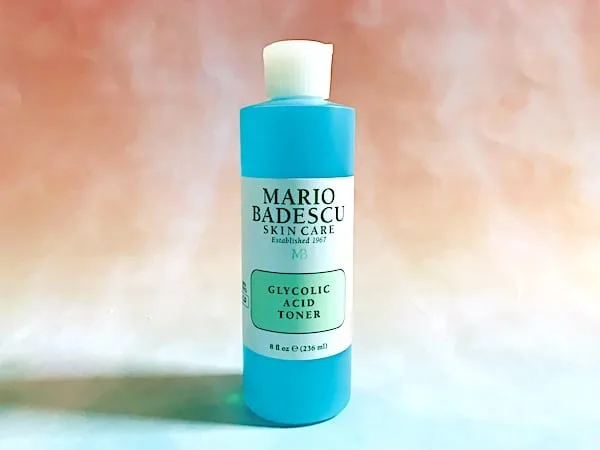
Mario Badescu Glycolic Acid Toner is an alcohol-free toner that contains 5% glycolic acid to gently exfoliate your skin.
Ideal for those new to glycolic acid, this low concentration is enriched with soothing aloe vera to calm the skin. The toner reduces the look of wrinkles, fine lines, and uneven skin tone while refining your pores.
With continued use, it brightens and balances the skin for a fresher, more radiant complexion. Please note that there is added fragrance in this glycolic acid toner.
The Ordinary Glycolic Acid 7% Toning Solution
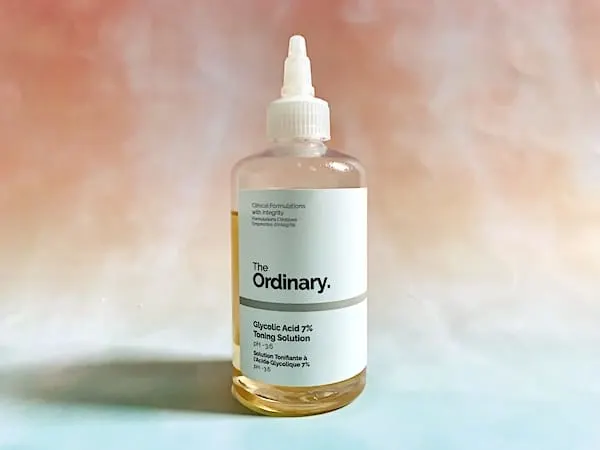
The Ordinary Glycolic Acid 7% Toning Solution contains 7% glycolic acid for a slightly stronger exfoliation than the 5% Mario Badescu toner above.
This exfoliating toner also contains a Tasmanian pepperberry derivative to reduce the irritation that glycolic acid can cause.
The toner is enriched with antioxidant ginseng extract and moisturizing glycerin. It also contains multiple amino acids, which are hydrating and water-binding.
Another great starter glycolic acid product, this affordable toner will improve skin radiance and clarity. It helps to improve skin texture, congestion, and uneven skin tone.
Paula’s Choice 8% AHA Gel Exfoliant
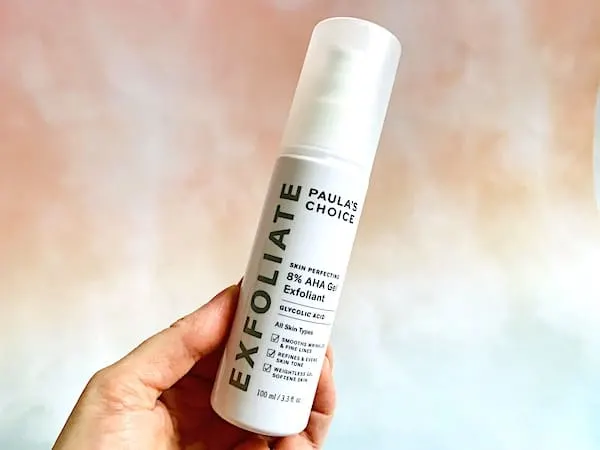
Paula’s Choice 8% AHA Gel Exfoliant is an exfoliating glycolic acid gel that contains 8% glycolic acid.
This leave-on-exfoliant sweeps away dead skin cells to reveal brighter, smoother and firmer, and more youthful-looking skin. It softens the look of fine lines and brightens your skin tone.
This exfoliating glycolic acid gel contains skin-soothing plant extracts like chamomile and aloe vera to reduce irritation.
Sodium hyaluronate (hyaluronic acid) hydrates and plumps while Sodium PCA and panthenol moisturize the skin.
Green tea is an antioxidant that offers anti-inflammatory benefits.
CeraVe Skin Renewing Nightly Exfoliating Treatment
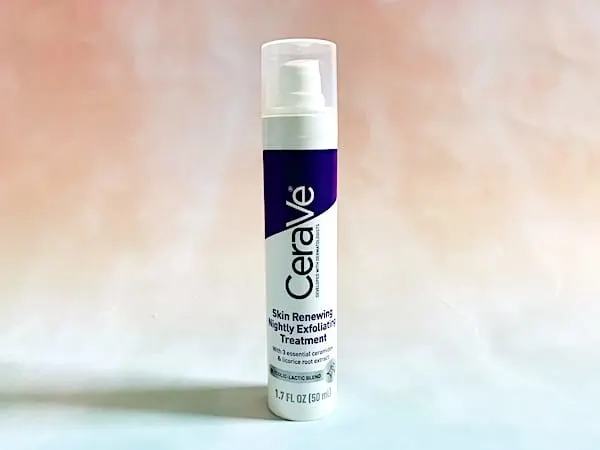
For a gentle drugstore chemical exfoliating treatment, CeraVe Skin Renewing Nightly Exfoliating Treatment contains a 5% blend of glycolic acid and lactic acid to reduce the look of fine lines and remove dead skin cells that cause your skin to look dull and discolored.
It does all this without redness, flakiness, or peeling.
With continued use, this treatment serum helps fade dark spots and reduce the look of enlarged pores.
It contains CeraVe’s proprietary blend of three essential ceramides to moisturize your skin and strengthen your skin barrier.
Licorice root extract brightens your skin complexion and reduces inflammation.
Sodium hyaluronate, a salt form of hyaluronic acid, acts like a sponge and draws moisture to your skin.
This AHA treatment uses CeraVe’s MVE Technology to continually release moisturizing ingredients for extended hydration.
The Benefits of Retinol
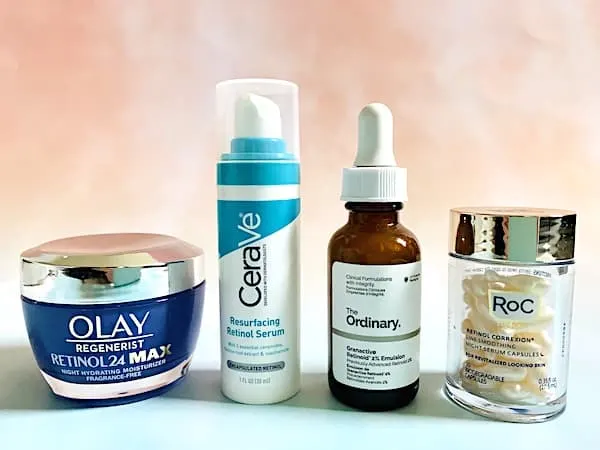
Retinol is a form of vitamin A that is converted to its active form, retinoic acid, in the skin. It reduces the appearance of fine lines and wrinkles by increasing collagen production and cell turnover in your skin.
It also helps to fade hyperpigmentation, sunspots, and other discoloration.
Retinol increases epidermal thickness and even alters collagen gene and protein expression in the skin, providing an anti-aging effect.
Retinoids also balance sebum (oil) production and help prevent the formation of comedones.
Comedones are clogged pores that can become blemishes like whiteheads or blackheads. Retinol also has anti-inflammatory benefits, which calm inflamed acne-prone skin.
It’s important to note that you should use sun protection when using retinol, like glycolic acid, since it makes your skin more sensitive to harmful UV rays.
It is best to use retinol and other retinoids in your evening skincare routine.
Retinol can be less irritating than stronger forms of vitamin A. However, irritation is still possible and may increase with higher retinol concentrations or in people who have sensitive skin.
If your skin gets too irritated from a retinol product, consider using it once every other day, every third day, or even once a week to minimize irritation.
Retinol Products to Try
Olay Retinol 24 MAX Night Hydrating Moisturizer
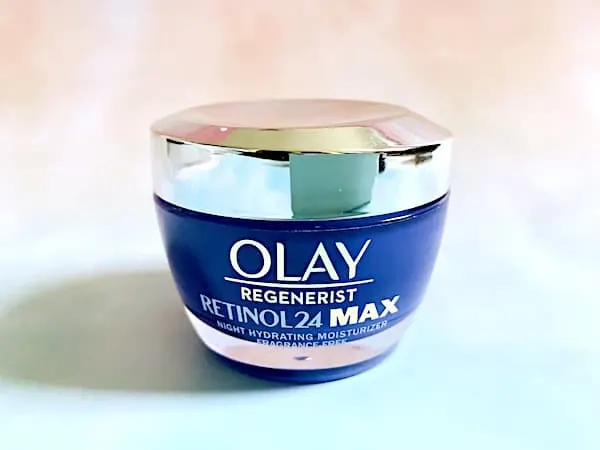
Olay Retinol 24 MAX Night Hydrating Moisturizer is formulated with Olay’s proprietary retinoid complex that contains two kinds of retinoids: retinol and retinyl propionate.
Retinyl propionate is a retinol ester that isn’t as strong as retinol but offers similar anti-aging benefits with fewer side effects.
This retinol moisturizer also contains niacinamide (vitamin B3), which helps smooth fine lines and wrinkles, fade hyperpigmentation and dark spots, and increases ceramide production to strengthen the skin barrier.
The Ordinary Granactive Retinoid Emulsion 2%
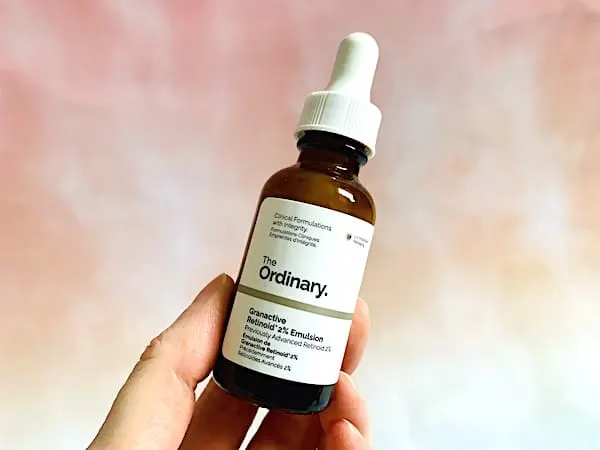
The Ordinary Granactive Retinoid Emulsion 2% is formulated with a 2% concentration of Granactive Retinoid that contains solubilized Hydroxypinacolone Retinoate (HPR).
HPR is a retinoid that is supposed to provide better anti-aging effects than retinol or other non-prescription retinoids without unwanted side effects like irritation, dryness, and flaking.
The serum also contains a sustained-delivery form of pure encapsulated retinol to improve the HPR’s effectiveness.
This is a creamy retinoid serum that is very gentle on the skin, making it ideal for those just starting out or who have sensitive skin.
It’s a retinol favorite here at The Skincare Enthusiast!
CeraVe Resurfacing Retinol Serum
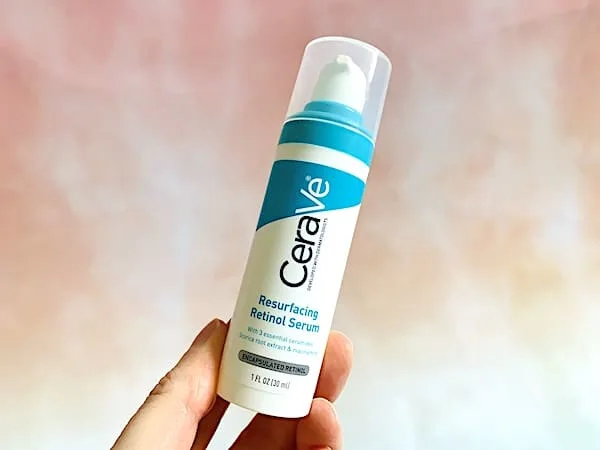
CeraVe Resurfacing Retinol Serum is another gentle retinol product from the drugstore brand CeraVe.
It is formulated to reduce the look of post-acne marks (post-inflammatory hyperpigmentation), pores, uneven skin tone, and irregular skin texture, making this retinol treatment ideal for those with oily and acne-prone skin.
The formula contains encapsulated retinol to resurface the skin, licorice root extract to brighten and soothe the skin, and CeraVe’s three essential ceramides to support a healthy skin barrier.
Niacinamide offers anti-inflammatory, sebum-regulating, barrier-strengthening, and skin-smoothing benefits.
CeraVe’s MVE Technology is a patented delivery system that continually releases moisturizing actives for long-lasting hydration.
Related Post: The Best CeraVe Products for Oily, Acne-Prone Skin
RoC Retinol Correxion Line Smoothing Night Retinol Serum Capsules
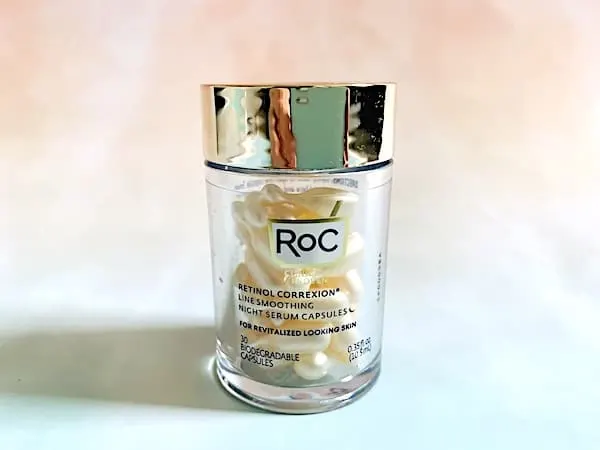
RoC Retinol Correxion Line Smoothing Night Retinol Serum Capsules are 100% biodegradable capsules that contain RoC retinol in soybean oil, a lightweight plant oil that moisturizes dry skin.
The capsules accelerate the removal of dead skin cells and reduce the appearance of wrinkles and fine lines while stimulating collagen and improving skin firmness.
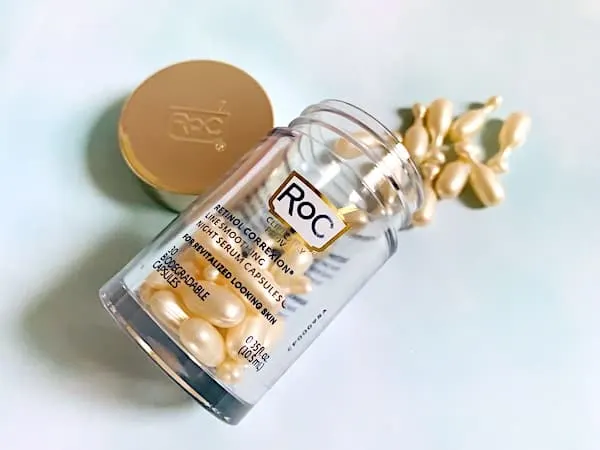
Each capsule is sealed individually for optimal freshness and potency. Just twist the capsule to release the product.
The premeasured dosage ensures that you get just the right amount. These little capsules are excellent for travel, too!
Using Glycolic Acid and Retinol Together
Glycolic acid and retinol are two of the few over-the-counter actives powerful enough to create visible improvements in your skin. They’re both excellent at smoothing, brightening, and improving skin radiance.
Whether you choose to use one or both, just be sure to start slow with each, as glycolic acid and retinol can cause irritation.
If you experience dry, flaking skin try applying a moisturizer or hydrating serum before applying your glycolic acid or retinol product.
For the best results, avoid using glycolic acid and retinol together on the same day, especially if you have sensitive skin.
Instead, use them at different times of the day or different days of the week. And be sure to wear sunscreen when using glycolic acid and retinol because they make your skin more sun-sensitive.
Thanks for reading, and until next time, here’s to your good skin health!
Related Post on Using Actives Together: Can You Use Azelaic Acid and Salicylic Acid Together?
